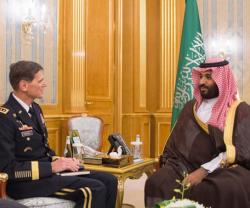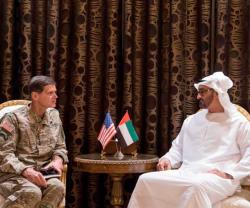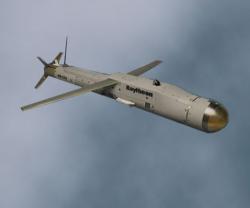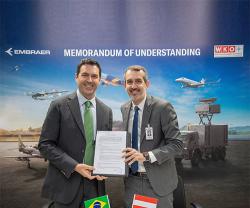More U.S. Warships in Asia by 2020
06.06.2012 North America
The United States will move the majority of its warships to the Asia-Pacific in coming years and keep 6 aircraft carriers in the region, Defense Secretary Leon Panetta said, giving the first details of a new U.S. military strategy.
Speaking at an annual Security Forum in Singapore this past week, Panetta sought to dispel the notion that the shift in U.S. focus to Asia was designed to contain China’s emergence as a global power.
Fleshing out details of the shift to Asia, Panetta said the United States would reposition its Navy fleet so that 60% of its warships would be assigned to the region by 2020, compared to about 50 % now.
The Navy would maintain 6 aircraft carriers assigned to the Pacific. Six of its 11 carriers are now assigned to the Pacific but that number will fall to five when the USS Enterprise retires this year.
The number will return to 6 when the new carrier USS Gerald R. Ford is completed in 2015.
The U.S. Navy currently has a fleet of 285 ships, with about half of those vessels deployed or assigned to the Pacific.
Some Chinese officials have been critical of the U.S. shift of military emphasis to Asia, seeing it as an attempt to fence in the country and frustrate Beijing’s territorial claims.
Panetta underscored the breadth of the U.S. commitment to the Asia-Pacific, noting treaty alliances with Japan, South Korea, Thailand, the Philippines and Australia as well as partnerships with India, Singapore, Indonesia and others.
He said the U would attempt to build on those partnerships with cooperative arrangements like the rotational deployment agreement it has with Australia and is working on with the Philippines.
Panetta said Washington also would work to increase the number and size of bilateral and multilateral military training exercises it conducts in the region. Officials said last year the United States carried out 172 such exercises in the region.
In laying out core U.S. principles in the region, Panetta made clear Washington opposed any attempt by Beijing to make unilateral moves in its push for territorial rights in the South China Sea, where a number of countries have overlapping claims.
Disputes had to be resolved through agreed-upon rules among all countries and based on international law, he said.
China has downgraded its representation to the Shangri-La Dialogue from last year, when Defense Minister Liang Guanglie attended and met then-U.S. Defense Secretary Robert Gates. This year the Chinese military was represented by the Vice President of Academy of Military Sciences.
By contrast, Panetta was accompanied by General Martin Dempsey, the military’s top Officer as Chairman of the Joint Chiefs of Staff, and Admiral Samuel Locklear, the Head of the U.S. Pacific Command.
Speaking at an annual Security Forum in Singapore this past week, Panetta sought to dispel the notion that the shift in U.S. focus to Asia was designed to contain China’s emergence as a global power.
Fleshing out details of the shift to Asia, Panetta said the United States would reposition its Navy fleet so that 60% of its warships would be assigned to the region by 2020, compared to about 50 % now.
The Navy would maintain 6 aircraft carriers assigned to the Pacific. Six of its 11 carriers are now assigned to the Pacific but that number will fall to five when the USS Enterprise retires this year.
The number will return to 6 when the new carrier USS Gerald R. Ford is completed in 2015.
The U.S. Navy currently has a fleet of 285 ships, with about half of those vessels deployed or assigned to the Pacific.
Some Chinese officials have been critical of the U.S. shift of military emphasis to Asia, seeing it as an attempt to fence in the country and frustrate Beijing’s territorial claims.
Panetta underscored the breadth of the U.S. commitment to the Asia-Pacific, noting treaty alliances with Japan, South Korea, Thailand, the Philippines and Australia as well as partnerships with India, Singapore, Indonesia and others.
He said the U would attempt to build on those partnerships with cooperative arrangements like the rotational deployment agreement it has with Australia and is working on with the Philippines.
Panetta said Washington also would work to increase the number and size of bilateral and multilateral military training exercises it conducts in the region. Officials said last year the United States carried out 172 such exercises in the region.
In laying out core U.S. principles in the region, Panetta made clear Washington opposed any attempt by Beijing to make unilateral moves in its push for territorial rights in the South China Sea, where a number of countries have overlapping claims.
Disputes had to be resolved through agreed-upon rules among all countries and based on international law, he said.
China has downgraded its representation to the Shangri-La Dialogue from last year, when Defense Minister Liang Guanglie attended and met then-U.S. Defense Secretary Robert Gates. This year the Chinese military was represented by the Vice President of Academy of Military Sciences.
By contrast, Panetta was accompanied by General Martin Dempsey, the military’s top Officer as Chairman of the Joint Chiefs of Staff, and Admiral Samuel Locklear, the Head of the U.S. Pacific Command.
Previous PostHarris Wins Side Falcon Soldier Radio Order
Latest news
Latest events
ISNR Abu Dhabi 2024
21 - 23 May 2024ADNEC Centre Abu Dhabi - United Arab EmiratesEUROSATORY 2024
17 - 21 Jun 2024Paris Nord Villepinte - FranceFarnborough International Airshow
22 - 24 Jul 2024Farnborough - United KingdomEgypt International Airshow
02 - 05 Sep 2024Alamein International Airport - Egypt






















